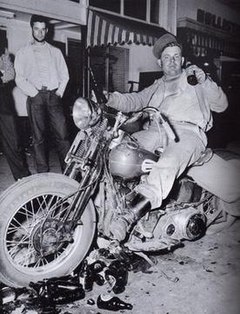Hollister riot

Eddie Davenport of Tulare, California on a motorcycle, with August 'Gus' Deserpa standing behind and left, at 526 San Benito St, Hollister, California, on July 4, 1947, by the San Francisco Chronicle's photographer Barney Petersen.
|
|
| Date | July 4, 1947–July 6, 1947 |
|---|---|
| Location | Hollister, California |
| Also known as | 1947 Hollister Gypsy Tour |
| Participants | 2,000 to 4,000 attendees, including about 750 motorcyclists. Members of the American Motorcyclist Association, Boozefighters, Pissed Off Bastards of Bloomington and other motorcycle clubs |
The Hollister riot was an event that occurred at the American Motorcyclist Association (AMA)-sanctioned Gypsy Tour motorcycle rally in Hollister, California from July 3 to 6, 1947.
Many more motorcyclists than expected flooded the small town to watch the annual rallies as well as to socialize and drink. A few of the motorcyclists got out of control and caused a commotion in the town, although at the end of the event, the damage was considered minor.
The incident, known afterwards as the Hollister riot, was sensationalized by the press with reports of bikers "taking over the town" and "pandemonium" in Hollister. The strongest dramatization of the event was a staged photo of a drunken man sitting on a motorcycle surrounded by beer bottles. It was published in Life magazine and it brought national attention and negative opinion to the event. The Hollister riot helped to give rise to the outlaw biker image.
After World War II, countless veterans came back to America and many of them had a difficult time readjusting to civilian life. They searched for the adventure and adrenaline rush associated with life at war that had now left them. Civilian life felt too monotonous for some men who also craved feelings of excitement and danger. Others sought the close bonds and camaraderie found between men in the army. Furthermore, certain men wanted to combat their horrifying war memories and experiences that haunted them, many in the form of post-traumatic stress disorder. Thus, motorcycling emerged stronger than ever as a substitute for wartime experiences such as adventure, excitement, danger and camaraderie. Men who had been a part of the motorcycling world before the war were now joined by thousands of new members. The popularity of motorcycling grew dramatically after World War II because of the effects of the war on veterans.
Throughout the 1930s, Hollister, California hosted an annual Fourth of July gypsy tour event. Gypsy tours were American Motorcyclist Association-sanctioned racing events that took place all over America and were considered to be the best place for motorcyclists to converge. The annual event consisted of motorcycle races, social activities, and lots of partying. In Hollister, the event and the motorcyclists were very welcome. Especially because Hollister was a very small town, with only about 4,500 people, the rally became a major event in its yearly life as well as an important part of the town's economy. Due to World War II, the rally was canceled, but the event organized for 1947 was the revival of the Gypsy Tour in Hollister.
...
Wikipedia
